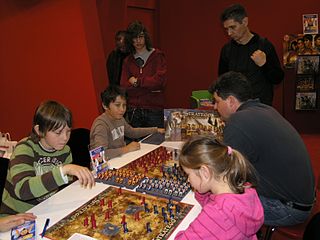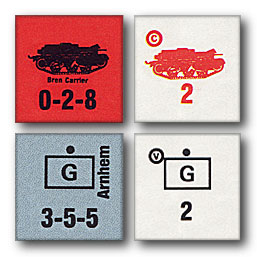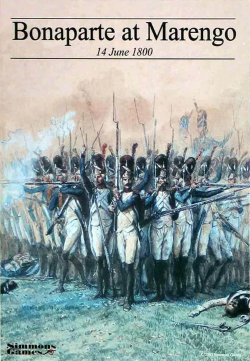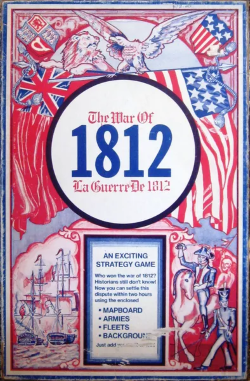
A block wargame is a board wargame that represents military units using wooden blocks instead of cardboard counters or metal/plastic miniatures.

A block wargame is a board wargame that represents military units using wooden blocks instead of cardboard counters or metal/plastic miniatures.
A block wargame uses wooden blocks to represent units. These blocks are typically square, have a labeled and an unlabeled side, and are generally thick enough that they can be placed on their side with the labeled side facing the owning player. Details about the unit (for instance, its identity as well as its attack, defense and movement scores) can then be seen easily by the owning player, while the opposing player will be left unsure of the exact nature of piece; while he can see where his rival's forces are, the fog of war is emulated by preserving the secrecy of the type and quality of the troops.
Often, block pieces display the main information in the center with a series of numbers (or pips) around the edge, so that the current strength of the unit can be shown in a "step-reduction" system (where a unit's strength is reduced step-by-step, as it takes damage during combat.) When the unit is undamaged, the largest number will be displayed at 12 o'clock. When the unit is damaged, the player turns it counterclockwise so that the next largest number is at 12 o'clock, with the number of pips at the top of block indicating its current strength. This continues until the unit's strength reaches zero, whereupon it is removed from play.
Alternatively, some block wargames require the player to remove the block representing the damaged unit from the board and replace it with a block with a lower strength.

The initial idea of pieces that are visible to only one of two players traces back to the 1908 introduction of the game L'Attaque, the first version of Stratego . Early Stratego pieces were cardboard but were replaced by wood after World War II. (Today Stratego pieces are plastic.) However Stratego was not a direct inspiration for block wargames.
In 1972, Lance Gutteridge of Gamma Two Games originally planned on using six-sided dice to represent pieces and to provide for step reduction in combat strength. The high cost of dice led him to decide to instead use embossed wooden blocks showing 2, 3 or 4 steps in combat strength. [1] The first such block wargame was Quebec 1759 , depicting the campaign surrounding the Battle of the Plains of Abraham. [2] Gamma Two Games later produced the block wargames War of 1812 , simulating the war of that name, and Napoleon , simulating the campaign leading up to the Battle of Waterloo. In 1982, Gamma Two changed its name to Columbia Games. [2]
Through the 1980s and 1990s Columbia Games was practically the sole publisher of block wargames. Their releases during this time included Rommel in the Desert, covering World War II's North Africa campaign; EastFront and its sequels, covering the European theater of World War II at the corps level; and Bobby Lee and Sam Grant, covering the Virginia and Western theaters of the American Civil War. The only significant change was to replace the relatively expensive embossed wooden blocks used in the old Gamma Two Games with plain plastic blocks. Each game then comes with a sheet of stickers to be affixed to the blocks. [2]
Block wargames are enjoying a minor resurgence. Columbia Games' Hammer of the Scots by designer Jerry Taylor has been well received. His next title, Crusader Rex also fared well by many. Jerry Taylor recently released another block game based on the War of the Roses. GMT Games entered the block wargame market in 2003 with the release of Europe Engulfed, a simulation of the entire ETO. A sister game, Asia Engulfed, was released in 2007, using blocks to represent fleets as well as ground forces.
GMT also released a block wargame series called Commands and Colors: Ancients which met with wide approval. Note that this series of games does not fall under the tradition definition of "block wargame" as the units have identifying marks on both sides of the blocks, eliminating the fog of war aspect of most Block Wargames. Simmons Games has published the innovative Bonaparte at Marengo, which was nominated for a 2005 award for Best Historical Simulation by Games Magazine ; the game features unique long blocks, reminiscent of the symbols used on battle maps.
Since 2011, VentoNuovo Games has modernized the block wargames sector with the use of new logical algorithms and the creation of ultra-detailed topographic maps. With 14 published titles, it is today the most active company in the sector.
In the inaugural issue of Command, Bill Stone called the idea of using blocks "not a bad idea, but too clumsy for use in games with high piece density." [3]

Stratego is a strategy board game for two players on a board of 10×10 squares. Each player controls 40 pieces representing individual officer and soldier ranks in an army. The pieces have Napoleonic insignia. The objective of the game is to either find and capture the opponent's Flag or to capture so many enemy pieces that the opponent cannot make any further moves. Stratego has simple enough rules for young children to play but a depth of strategy that is also appealing to adults.

A wargame is a strategy game in which two or more players command opposing armed forces in a simulation of an armed conflict. Wargaming may be played for recreation, to train military officers in the art of strategic thinking, or to study the nature of potential conflicts. Many wargames re-create specific historic battles, and can cover either whole wars, or any campaigns, battles, or lower-level engagements within them. Many simulate land combat, but there are wargames for naval, air combat, and cyber as well as many that combine various domains.

Columbia Games is one of the oldest manufacturers of board wargames, and has also produced the Hârn role-playing game as well as various card games and collectible card games. Their wargames are notable for using small wooden or plastic blocks instead of the more conventional cardboard counters. The company, originally titled Gamma Two Games, started in Vancouver, Canada, but after ten years changed its name to Columbia Games, and eventually moved to Blaine, Washington. It is currently run by founder Tom Dalgliesh and his son Grant.

The Russian Campaign is a strategic board wargame published by Jedko Games in 1974 that simulates combat on the Eastern Front during World War II. Avalon Hill later bought the game and produced several editions.

Napoleon, subtitled "The Waterloo Campaign, 1815", is a strategic-level block wargame published by Gamma Two Games in 1974 that simulates the Battle of Waterloo. A number of versions of the game have been produced by Avalon Hill and Columbia Games.
Battle Cry is a board wargame based on the American Civil War, designed by Richard Borg and published by Avalon Hill in 2000.

Tactical wargames are a type of wargame that models military conflict at a tactical level, i.e. units range from individual vehicles and squads to platoons or companies. These units are rated based on types and ranges of individual weaponry. The first tactical wargames were played as miniatures, extended to board games, and they are now also enjoyed as video games.

Kriegsspiel is a genre of wargaming developed by the Prussian Army in the 19th century to teach battlefield tactics to officers. The word Kriegsspiel literally means "wargame" in German, but in the context of the English language it refers specifically to the wargames developed by the Prussian army in the 19th century. Kriegsspiel was the first wargaming system to have been adopted by a military organization as a serious tool for training and research.

A counter is usually a small cardboard square moved around on the map of a board wargame to represent relevant information or determine certain things. The first wargame based on cardboard counters was War Tactics or Can Great Britain Be Invaded? invented by Arthur Renals of Leicester in 1911. The first wargame bringing counters to a mass-market was Tactics, invented by Charles S. Roberts in 1952. Traditional wargames typically have hundreds of counters. Squad Leader had counters of different sizes: 520 1⁄2-inch counters and 192 5⁄8-inch, with the different sizes used for different purposes.

Bonaparte at Marengo is a strategy board wargame published by Simmons Games in 2005 that simulates the Battle of Marengo during the War of the Second Coalition in 1800.

Panzergruppe Guderian is a board wargame published by Simulations Publications, Inc. in 1976 that simulates the 1941 Battle of Smolensk during World War II.

Commands & Colors: Ancients is a board wargame designed by Richard Borg, Pat Kurivial, and Roy Grider, and published by GMT Games in 2006. It is based on Borg's Commands & Colors system using some elements similar to his other games such as Commands & Colours: Napoleonics, The Great War, Memoir '44 and Battle Cry designed to simulate the "fog of war" and uncertainty encountered on real battlefields.

A board wargame is a wargame with a set playing surface or board, as opposed to being played on a computer or in a more free-form playing area as in miniatures games. The modern, commercial wargaming hobby developed in 1954 following the publication and commercial success of Tactics. The board wargaming hobby continues to enjoy a sizeable following, with a number of game publishers and gaming conventions dedicated to the hobby both in the English-speaking world and further afield.

War of 1812, subtitled in the first edition "La Guerre de 1812", is a board wargame published in 1973 by Gamma Two Games,, that simulates the War of 1812.

Europe Aflame is a board wargame published by TSR in 1989 that simulates the European and Middle East theatres of World War II.

EastFront, subtitled "The War in Russia: 1941–45", is a board wargame published by Columbia Games in 1991 that is simulation of the conflict between Germany and the Soviet Union during World War II.

Quebec 1759 is a board wargame published in 1972 by Gamma Two Games that simulates the Battle of the Plains of Abraham outside the walls of Quebec in 1759. The game uses wooden blocks set on their edge rather than the more traditional cardboard counters, unique for a wargame in 1972.

EuroFront, subtitled "War in Europe, 1939-45", is a set of board wargame rules published by Columbia Games in 1995 that allows the previously published EastFront, WestFront and MedFront wargames to be combined into one campaign that simulates the entire European Theatre of World War II. In addition to the Allied and Axis counters in these three games, EuroFront also adds pieces representing many other nationalities such as Dutch, Polish and Greek.

Rommel in the Desert is a block wargame published by The Game Preserve in 1982 that simulates the North African campaign during World War II.